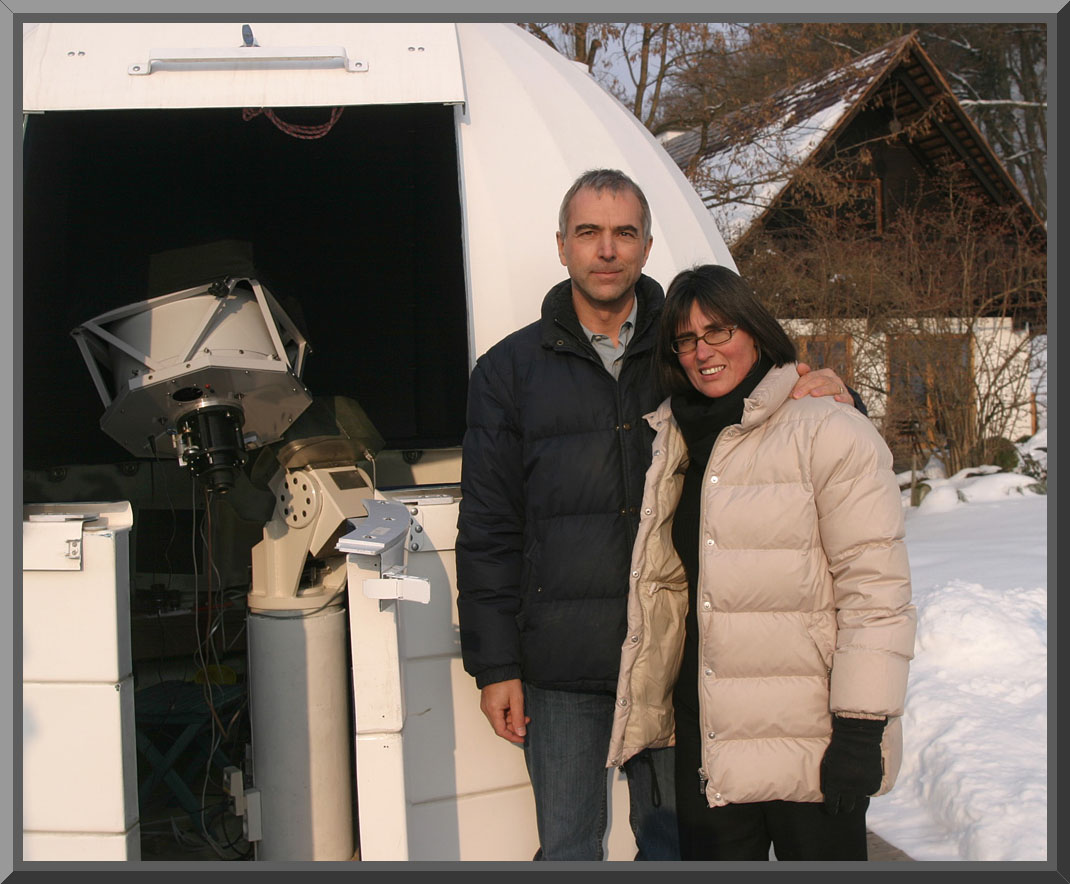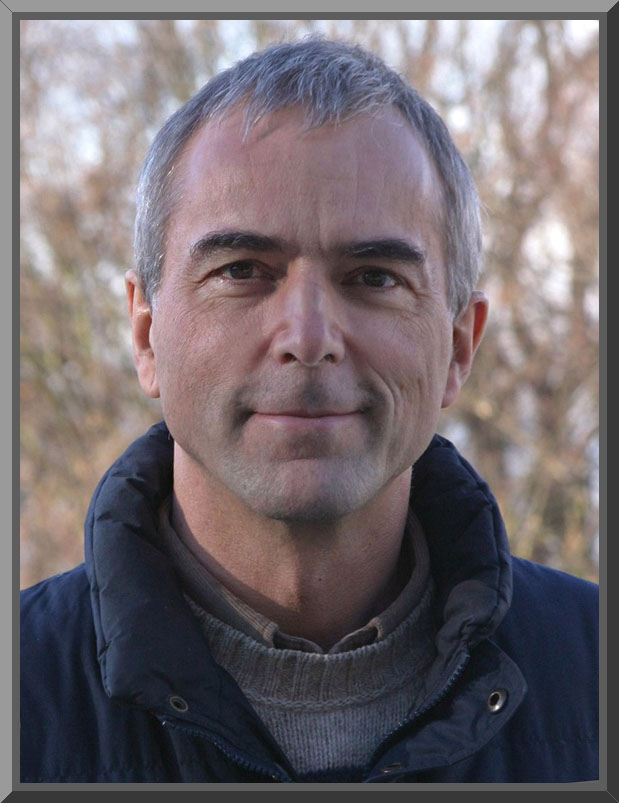|
Contact
information
e-mail
J.schedler@panther-observatory.com
.
website
http://panther-observatory.com
.
Locator
Map
http://www.frappr.com/apppublic
Level of accuracy: town of Wildon, Austria
Biography
I was
born in 1953 in Graz,
Austria, but spent my
youth in a small village in western Tyrol doing a lot
of skiing and mountaineering.
Since age 15 I
was
passionately doing chemistry experiments and electronics in my free time
and after finishing
secondary school studied
Technical Chemistry in Graz.
Starting from 1977
I
developed
new solutions for
industrial waste water cleaning and waste gas purification
and in 1985
co-founded
the Austrian Air Pollution Control company named
CTP which I currently
manage.
My astronomical life started in 1997 with a simple
Tasco reflector, a gift for my second son. He
soon lost interest in his scope, so I tried it out and
and began to explore the Moon and the Planets. Because of the need
for higher quality and magnification I soon
upgraded to the Meade ETX90 which made for
better planetary viewing. In
1998 I joined the local astronomy club and acquired a C11 on a G11 mount.
Astro-related photographic
film experiments failed, but in 1999 I successfully introduced a webcam
for planetary imaging and motivated other colleagues of my club to do the
same. My wife Roswitha supported my new hobby
fascinated from the endless variety of objects to observe and to image.
To escape the painful setup installation every night I built my own 3m
observatory beside my house 25 km south of Graz during summer 2000 in a
semi-rural environment (mag 5 sky typical).
Another big step into deep sky astrophotography was the use of a digicam,
first the Nikon CP995, then replacing it 2001 with the Canon D60 and 2002
with the Canon 10D. A MX7C was used for
autoguiding.
My second high quality scope was a
4” f/6.5
TMB APO
refractor. Ironically most
times I was guiding with the C11 and imaging with the 4” refractor.
I accepted the lower cost and big chip size of the
Canon D-SLR with reduced efficiency, as no reasonable priced CCD cameras
were available up to 2003. To overcome the low
quality of these raws I tried to compensate it by long multiple exposures
and tricky Photoshop processing. By doing this I was pushing the limits of
digicam imaging. At the beginning of the year
2004 SBIG released the STL-11000, the first full frame CCD camera and I
got one of the first models.
During the year 2004 I consequently explored mainly
nebulas using the wide
corrected field of my TMB. Also in 2004 my wife
and I did our first trip to Namibia, using most of the nights to image
many fascinating southern targets with the 4" TMB and the STL on my mobile
setup.
Intense E-mail communication with colleagues all over
the world pushed my experience in image acquisition and processing.
Another dream came true in early 2005
when after a 2 years wait my 16"
Cassegrain from P. Keller was finished and
installed in my observatory. This was
a big step forward and allowed for imaging
objects of various sizes in both
medium to high resolution. Because of the f/3
option of my Cassegrain,
I tend to specialise in
wider-field images.
Additionally, I am doing high resolution imaging
using the STL-11000 with the cassegrain f/10 setup at 4 m focal lenght as
well as with a firewire b/w webcam typically at f/20 for planets, Moon and
Sun. In November 2005 I was invited to
speak at the Advanced Imaging
Conference in San Jose, California where
I spoke on imaging with the STL-11000.
It was a great
experience because I met many famous astro-imagers in person and enjoyed
talking directly with them the first time.
Also in November
2005 I exchanged my 4” TMB against a TEC-140 f/7 APO refractor with field
flattener to improve the resolution for my mobile setup. This setup was
used intensely for astro-imaging during my 2 week's stay in Hakos/Namibia
in Mai 2006.
Astrophotography publications
Magazines
Astronomie heute:
Articles and images
Vatican Observatory Calendar 2006, 2008:
Images
Interstellarum:
Front page,
articles and images
Sky & Telescope:
Front pages,
articles and images
Practical Astronomer:
Front page and
images
Ciel & Espace: Front page, articles and images
Coelum: Front page and images
.
Books
Digital Astrophotography (Ratledge
David Ed.)
Chapter: Deep Sky Imaging with a Digital SLR
UNIVERSE (2005 by DK):
Images
.
Double and Multiple Stars:
Images
Himmelskalenderen 2007: Images
Beautiful
Universe 2008: Chapter with images
.
Internet
NASA APODs: 2003, 2004, 2005, 2006, 2007
Universetoday.com
Observing site
Panther Observatory at Wildon, Austria
Latitude: 46° 53‘ 03” North
Longitude: 15° 30‘ 28” East
Elevation: 400 meters (1312 feet)
Astronomical Equipment
Telescopes
Astro-Optik
410 mm (16-inch) Cassegrain by
Phillip
Keller
with corrected prime focus at f/3 and uncorrected secondary focus at f/10
TEC 140mm f/7 APO refractor with flattener
.
Recommended lenses
Canon EF 200 mm f/2.8 L
Canon 100mm f/2 lens
Sigma 20mm f/1.8 lens
.
Mount
MK 100 German
Equatorial Mount (100 mm axes, 200 kg weight)
by
Michael Knopf
on top of a 12" concrete pier
.
Telescope control
FS2 Goto control by Michael
Koch Elektronik
.
Cameras
SBIG STL-11000 with 8
pos. filter wheel
Canon 40D
DMK21BF04
.
Filters and holders
Astronomik
2" LRGB filter set
Baader 50.6 mm CLRGB
filter set
Baader 7 nm H-alpha filter 51mm
Baader 8 nm S-II filter 51mm
Baader 8 nm O-III filter 51mm
Baader Astrosolar filter
Baader continuum filter (narrow green) for solar imaging.
Lumicon UHC filter 50mm
Atik 5x filter wheel 1,25"

Johannes and wife Roswitha
at their Panther Observatory
|

